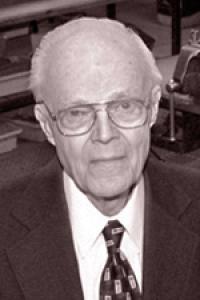
Garman Kimmell grew up in Wichita, Kansas, in the early 20th century, where his father had moved to pursue his business dealings. Kimmell attended Wichita State University for two years before transferring to the University of Oklahoma because of its strong engineering program. Kimmell graduated in 1937 with a Master of Science degree in Petroleum Engineering.
While still pursuing his master’s degree, Kimmell was hired by Black, Sivalls & Bryson, one of the world’s foremost designers and builders of oil and gas process equipment systems and plants. He worked there for over a decade, rising to the rank of chief research engineer before declining the company’s offer in 1948 of a further promotion and move to Kansas City, because he wanted to remain in Oklahoma City. He resigned from Black, Sivalls & Bryson and founded Kimray, an oil and gas equipment and controls manufacturer.
Garman revolutionized the field production of oil and gas with his 3″ SGT-BP valve. A marvel of American ingenuity, it marked the first time an affordable product of this sort could succeed in the field. It cost only $105, and only $280 today. And as befits a true story of Americana, Kimmell first peddled it out of the back of a pickup truck. Over the next 15 years, his creative genius spawned a dozen more watershed products, all of which – along with their variations and derivatives – have had lasting impact on the oil and gas industry.
Kimmell’s experiments weren’t limited to mechanical valves. In 1957, he invented an energy exchange glycol pump that eliminated the polluting of land around oil fields caused by the leaking of glycol. Hill estimates that Kimray now builds 99 percent of all the oil field exchange pumps in the world. The company’s glycol pumps, treater valves, oil dump valves, high pressure control valves, and pilots – totaling in the millions – now operate in almost every oil field lease on the planet, from the United States to Africa to Australia.
His body of work stretches far beyond his epochal contributions to oil and gas production to the medical field, electronics, audio products, the arts, and music. Nearly all his contributions possessed a common denominator: solving people’s problems.
In the 1960s, he developed a heart-lung machine and served as the technical physicist on the first open-heart surgery team in Oklahoma City. The device allowed heart doctors to perform lengthy open-heart surgeries. He created de-bubblers and oxygenators (from stainless steel canisters conscripted from his wife’s kitchen) for the blood as it was recirculating outside the body. Kimmell devoted thousands of hours of his own time toward these humanitarian pursuits – without remuneration. When asked why, he responded, “I guess the best answer is simply the philosophy expressed in the parable of the Good Samaritan: Here’s a chance to help people with congenital heart problems. My reward has been actually seeing the sick made whole, but I wouldn’t be in it at all if it weren’t for the dedication of those doctors. I may have gone the mile, but they’ve gone the extra mile.”
Kimmell considered the vena cava filter as one of his most significant inventions. Kimmell grandson, current Kimray President Thomas Hill, noted the interesting way in which Kimmell designed products: “He put nothing on paper until he worked it all out in his mind,” the younger Hill says, “and when he did put it on paper, he would do so on the reverse side of scrap paper or, if at a restaurant for lunch, a napkin. He drew the new invention by hand, in the proper proportion, notating the size, shape, and dimensions for each piece.”
“Some of the napkins we would get back from Garman had prints on them he had drawn at lunch and they were as good as the ones we got from the Drafting Department,” says retired Kimray machine shop manager Don Huffstutlar. “I would imagine that most of our really great products started out on a napkin!” adds David Hill.
From there, Kimmell proceeded to his home shop and created wooden parts for his new design, making sure they all fit together and worked properly. “Next,” says Tom Hill, “he would take his drawings to Kimray, asking the men in the various shops which parts they wished to make. He would return home and make the remaining parts with his own hands and shop tools. Then, he and the others would assemble the product and begin testing it.”
Hill adds that his grandfather believed in a strict interpretation of the Constitution. “He reminded us on a regular basis that it was our responsibility, that government rested on our shoulders, that if we were not involved in the process, if we did not stand up to be counted, if we did not put our money and effort into insuring that the right things got done, we would be the ones to blame if things weren’t done.” Apparently, Kimmell applied the general precepts for personal responsibility to his own life. None of his family or friends remembers him ever blaming anyone else for something he did or that happened to him.
He shared all these beliefs with The John Birch Society, and long supported them, to the extent of his ability to do so. He passed his passion for the JBS and its often-courageous stands on to his son-in-law Tom Hill, a faithful proponent of the organization, and his other kinfolk.

